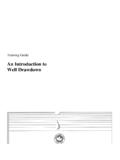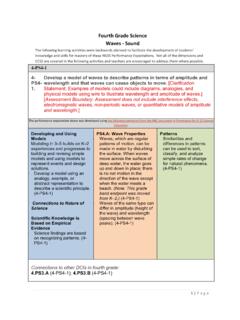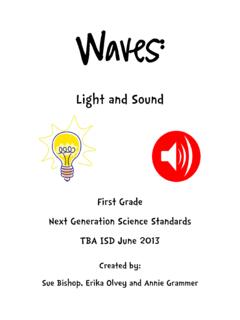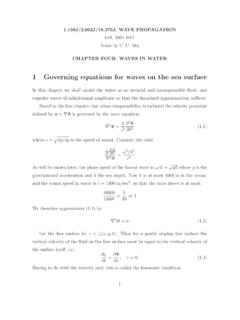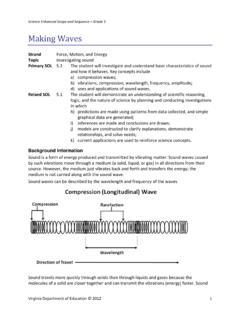Transcription of Science Enhanced and Sequence Making Waves, Music, and …
1 Science Enhanced Scope and Sequence Grade 5 Making waves , Music, and Noise Strand Force, Motion, and Energy Topic Investigating sound Primary SOL The student will investigate and understand basic characteristics of sound and how it behaves. Key concepts include b) vibration, compression, wavelength, frequency, amplitude; d) uses and applications of sound waves . Related SOL The student will demonstrate an understanding of scientific reasoning, logic, and the nature of Science by planning and conducting investigations in which b) estimates are made and accurate measurements of length, mass, volume, and temperature are made in metric units using proper tools; c) estimates are made and accurate measurements of elapsed time are made using proper tools; d) hypotheses are formed from testable questions; g) data are collected, recorded, analyzed, and communicated using proper graphical representations and metric measurements; j) models are constructed to clarify explanations, demonstrate relationships, and solve needs.
2 Background Information Sound is a form of energy produced and transmitted by vibrating matter. Sound waves caused by such vibrations move through a medium (a solid, liquid, or gas) in all directions from their source. However, the medium just vibrates back and forth and transfers the energy; the medium is not carried along with the sound wave. Sound waves can be described by the wavelength and frequency of the waves . virginia department of education 2012 1 Science Enhanced Scope and Sequence Grade 5 The frequency of the vibrations determines how high or low the pitch of the sound is. The faster the object vibrates, the higher the frequency and the higher the perceived pitch; the slower the object vibrates, the lower the frequency and the lower the perceived pitch.
3 The size and shape of an object will affect the pitch at which it resonates. Sound travels more quickly through solids than through liquids and gases because the molecules of a solid are closer together and, therefore, can transmit the vibrations (energy) faster. Sound travels most slowly through gases because the molecules of a gas are farthest apart. Some animals make and hear frequencies of sound vibrations (pitches) that humans cannot make and/or hear. Musical instruments vibrate to produce sound. Musical instruments vibrate to produce sound. There are many different types of musical instruments and each instrument causes the vibrations in different ways. The most widely accepted way to classify musical instruments is to classify them by the way in which the sound is produced by the instrument.
4 The four basic classifications are percussion instruments ( , drums, cymbals), stringed instruments ( , violin, piano, guitar), wind instruments ( , flute, clarinet, trumpet, trombone), and electronic instruments ( , electronic organ, electric guitar). Materials Instruments of teacher choosing (two to three instruments including a guitar) Drinking straws made of paper, not plastic one per student Rulers Watches Copies of activity sheet Squawker: A Sound Exploration Vocabulary wave, frequency, vibrations, pitch, sound, resonator Student/Teacher Actions (what students and teachers should be doing to facilitate learning). Introduction 1. Explain that sound plays a critical role in our everyday lives. One way sound brings enjoyment to people is through music.
5 Explain that in this lesson the students will begin exploring some musical sounds. 2. Play an instrument and discuss how it makes sounds with the students. 3. Ask students what part of the instrument is Making the sound. For example, if you are playing a stringed instrument, ask: How do the strings affect the sound? How do the strings vary? Does the hole in the center affect the sound? What part of the instrument resonates? What happens if the force that is put on the instrument is changed (blow harder, strum harder, faster)? Discuss frequency and pitch. virginia department of education 2012 2 Science Enhanced Scope and Sequence Grade 5 4. Explore a couple of instruments and discuss how the sound is made by each instrument before asking the students to begin their hands on investigation.
6 Procedure 1. Distribute paper straws, scissors, and copies of the attached worksheet Squawker: A Sound Exploration to the students. 2. Have the students measure and then flatten one inch of the one end of their straw, using a ruler for both tasks. 3. Then have students make two diagonal cuts with scissors to the flattened end of their straws, as shown on the worksheet Squawker: A Sound Exploration. 4. Have one student use the stopwatch to write down the start time and end time of blowing into the squawker. Tell the students to blow through the open end of their straw for as long as possible, but at least greater than three seconds. Have students record the elapsed time that they blew on the squawker. Blowing on their squawker should create a squawking sound.
7 5. Ask them what part of the straw is vibrating to make the sound and what part of the straw is acting as a resonator. Ask the students what they think will happen if the straw is shortened. 6. Have the students predict how the pitch will change and have half the class test the prediction by cutting their straws to a shorter length. Then conduct a sound comparison by having these students blow their squawkers one at a time, followed immediately by several students blowing their original length squawkers one at a time. Blow on the squawkers in this experiment for at least three seconds as well. Ask them to record their start time and stop time and then find the elapsed time they blew on the squawker. 7. Compare the sounds of the shorter squawkers with the sounds of the longer ones and draw a conclusion about how pitch changes with length.
8 8. Ask students to use their watches and explore using different time lengths to test their squawkers. Ask them to record their start time and stop time, then find the elapsed time they blew on the squawker. Observations and Conclusion 1. Discuss that the squawkers make sound by producing vibrations. Moving air causes the pointed ends of the straw to move rapidly back and forth that is, to vibrate. Woodwind instruments, such as clarinets, use a reed that vibrates in a manner similar to the pointed end of the squawker. The length of the straw, in part, determines the kazoo like sound that is created by the squawker. As the length of the straw is shortened, the pitch of the sound produced becomes higher. This is because the air in the shorter straw naturally resonates at a higher frequency.
9 Sound waves with a higher frequency cause sound with a higher pitch. 2. Discuss how the time of blowing in the squawker affected the experiment. What role did the time play? 3. Have students complete the questions at the bottom of the Squawker: A Sound Exploration worksheet. virginia department of education 2012 3 Science Enhanced Scope and Sequence Grade 5 Assessment Questions o What causes the sound the squawkers make? (Vibrations cause sound. Vibrating objects transmit sound waves to other media, such as air, and they travel in all directions.) o Compare the sounds of the shorter squawkers with the sounds of the longer ones and draw a conclusion about how pitch changes with length. o What is resonating?
10 Journal/writing prompts o Reflect on the different experiences you have had with the sound experiments today. Other o Do one of the following demonstrations for the class: resonating box and tuning fork, singing tube, popping tube. Have the students explain the Science behind the demonstration, using Science language and the basic concepts they have learned about sound. Encourage students to include diagrams with their explanations. Extensions and Connections (for all students). Have students design and make an instrument that (1) is durable and can be played, (2) can play both high and low pitches, and (3) can be played both loudly and softly. For the design process, encourage them to focus on cause/effect relationships and use a flow chart as a graphic organizer.










